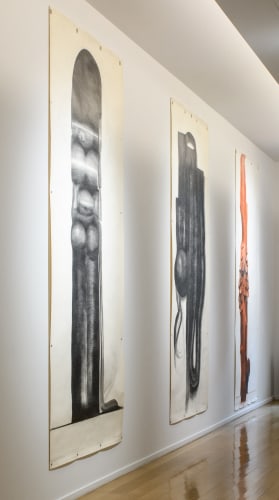Leon Tovar Gallery is pleased to announce its participation in Master Drawings New York 2022 in conjunction with the opening of our new gallery space at 26 East 64th Street. For this year's presentation, Leon Tovar Gallery celebrates the highly experimental and Surrealist-informed style of represented artist Agustín Fernández by presenting a selection of large-scale works on paper.
Born in Cuba in 1928, Fernández received his art education from the Academy of San Alejandro in Havana, before attending New York’s Art Students League, where he studied with George Grosz and Yasuo Kuniyoshi. i In 1953, he relocated to Spain where he enrolled in the San Fernando Academy and began to exhibit his work. The year 1959, however, marked an important transition for the artist; not only did he move to Paris on a fellowship from the Cuban government, but his artistic style shifted as well—“I found my true self as a painter at the beginning of the 1960s,” the artist says, “when I was more than thirty years old.” ii
Fernández practiced drawing alongside painting throughout his long career. Neither preparatory studies nor sketches, the aesthetic qualities of black graphite on white paper nevertheless informed the stark contrasts found in his paintings of the late 1960s and early 1970s. Taken as a whole, Fernández’s body of drawings is an expansive repertoire of mark-making techniques: rhythmic, lashing strokes; washes of diffused graphite; and heavily worked, darkened moments, all working to construct mutable and unnamable objects that inhabit the dream-like space of a largely untouched ground. The deft modeling of his drawings allows his forms to seemingly float before the page itself as if hanging in a state prior to language and law. In an unpublished text on Fernández’s drawings, the curator Donald Kuspit has likened the vast expanses of white paper to the space of the unconscious, the black graphite—standing against this backdrop, or emerging from it—the images of the conscious mind. That the dark forms seem independent of the white paper “makes them more ‘outstanding,’ so that they seem completely objective and autonomous, but it also suggests that they are subjective illusions, hallucinations in the white desert, and as such soon to collapse into its emptiness, all the more so because they are eccentrically constructed and as such inherently unstable.”
Fernández’s broad art historical references and interests—from ancient Greek statuary, to flattened Medieval icons, and the liveliness of the Baroque masters— consolidates within his work fruitful and vexing sets of connections. For, if Donald Kuspit finds within Fernández’s paintings and drawings a Surrealist preoccupation with the pre-Oedipal state, it is equally possible to find the influence of Fernández’s heroes, namely the painters Caravaggio and Velázquez. Despite their widely different subjects, Fernández’s work sparks an uncanny formal dialogue with these art historical giants. Exquisitely modeled forms play their part in the orchestration of dramatic movement that threatens to spill from the pictorial surface and invade the space of the viewer. Before a Fernández composition, we feel a similar sense of expectation and curious unease as when standing before Velázquez’s Las Meninas. The latter famously pulls the viewer into its world through compositional complexity and the play of gazes, reversing the traditional relationship of the spectator to the image. Rather than looking through the picture of plane of Las Meninas, one is under the impression that they are being looked at by the painted figures. Likewise, Fernandez’s powerful and mysterious compositions stand apart from the white confines of the paper; they push outward from the picture plane as a sculptural mass, confronting and engaging spectators with uncanny forms.

